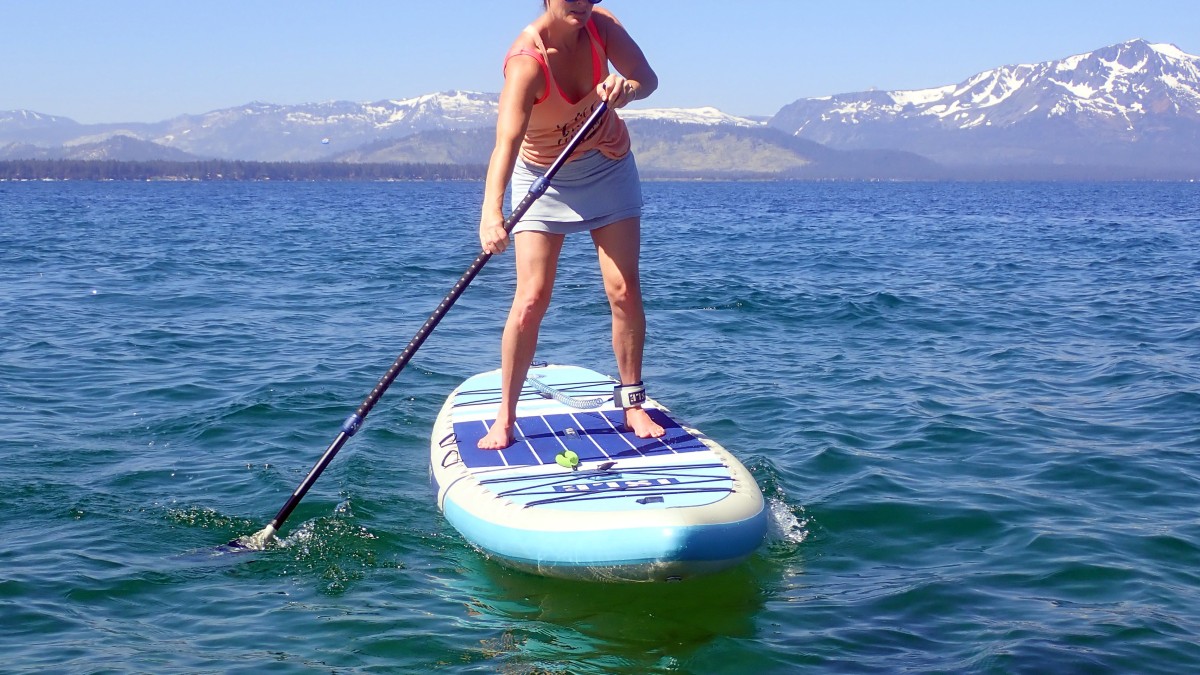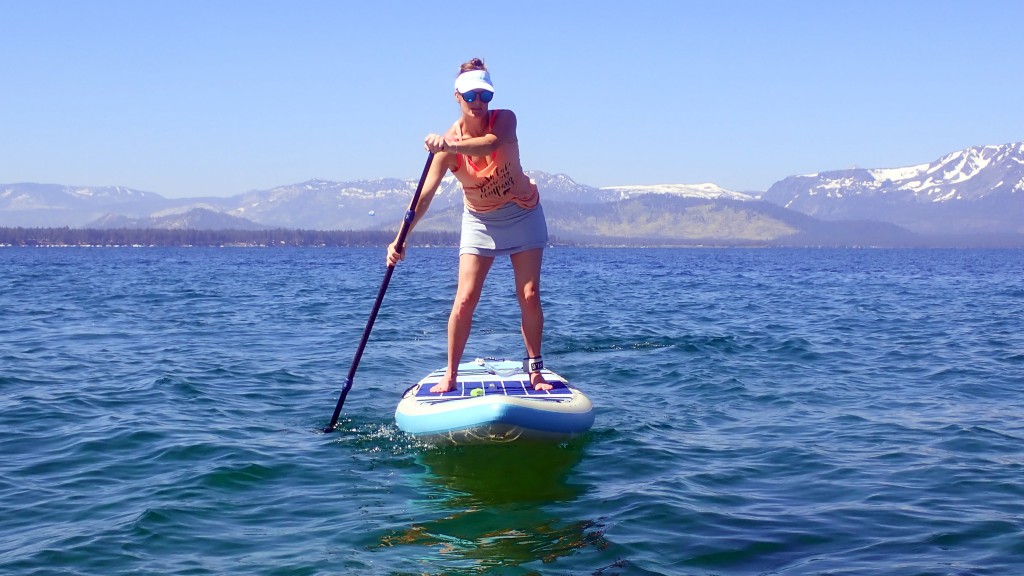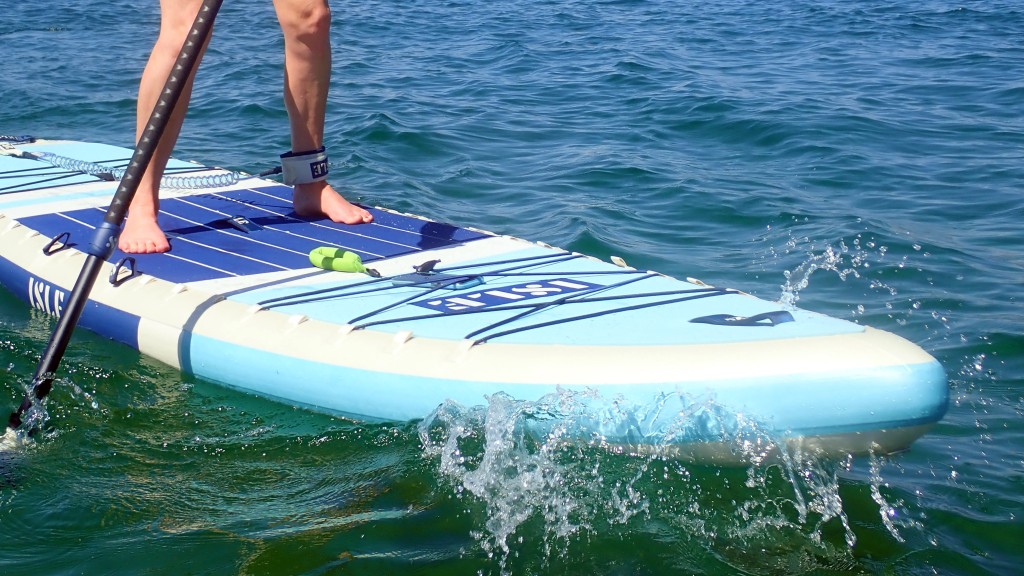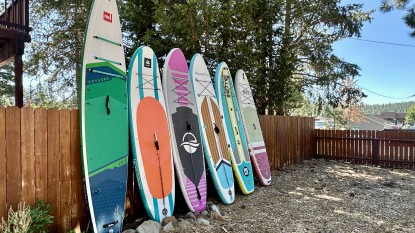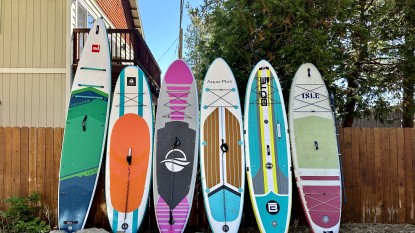Our Verdict
Our Analysis and Test Results
Setting up the Isle Switch as a kayak when you need a SUP break is easy and comfortable thanks to the unique design that includes an inflatable seat and footrest. While not the longest board we've tested at 11 feet and 7 inches long, it's up there, and the performance is notably better. Rather than D-rings, the Switch has soft loops that line each side of the board, called the Isle-Link Connect System, and special G-hooks for attaching the kayak seat. There are also velcro loops for your paddle, should you need to free up a hand. The long deck pad and cargo nets on the front and back round out this board with plenty of places to put your stuff while out on the water.
Performance Comparison
Stability
SUP purists did not prefer this board, and beginners felt it was unsteady. While it is more stable than most, due to the width and length, it rocked quite a bit in rollers and got bounced around by boat and wind chop. Still, experienced paddlers had no trouble walking forward and back on the board during testing, and yoga asanas, including inversions, were easily accessible. When converted to a kayak, our beginner kayakers and paddlers were impressed at how much more stable the Switch felt. The seat adds comfort and enough height off the board to provide additional leverage to control the board's movement more fully.
Isle uses Fusion Light PVC, a single layer of reinforced PVC material bonded to lightweight woven drop-stitch fabrics, to decrease weight. The board is also built using cross-threaded drop stitching, where the thousands of fibers that run between the top and bottom layers inside the board cross each other in an 'X' pattern. This reduces weight without sacrificing stiffness. This stiffness improves stability — though the light weight build sacrifices durability. You may be utilizing the repair kit if you choose to take the Switch out on creeks or rivers.
The center fin requires a single screw to attach it to the board. Be sure to keep an eye on this screw and be careful not to drop it. Once attached, the 9-inch long fin does a relatively good job, but we would prefer two additional fins to balance it out. Solo, lighter paddlers will feel little side-to-side rock. As with all boards, adding additional weight will make this board less stable.
Glide Performance
The length and width of the Switch mean that it won't move as fast as shorter, thinner boards. We found that paddling required more effort than smaller boards, and the heavy paddle that's included increased this work. That said, the slight rocker at the front of the board lifts it out of the water and decreases drag. And, designed with the shape of a touring board with a planing hull and rounded nose, the relatively lightweight Switch glides better than other boards of its size. Considering the max capacity for this board is 425 pounds, it makes sense that taller, heavier paddlers could propel it more easily and quickly than shorter and smaller folks. Additionally, this is another metric where the Switch performed better as a kayak than a SUP board. Regardless of body type, testers found that the board moved more easily and quickly when converted to a yak.
No hybrid board is going to be perfect at all things. The Switch does a great job of gliding smoothly when loaded with people, gear, or pets. It performs well on lakes and rivers even when loaded up. It's not the kind of board we recommend taking long distances, but we would definitely pack it for a casual day of paddling and picnicking or kayaking with a buddy. A better-quality paddle would be an excellent upgrade for this board if you'd like to travel for longer.
Maneuverability
We suggest choosing a different board if maneuverability is crucial for you. Even when using a lightweight carbon paddle, the Switch is slow to turn around buoys or to bring about when changing directions. When approaching rolling waves head-on, this board would rock up and over rather than cut through the crests. The board also felt unstable in chop — beginners and smaller paddlers found it difficult to maintain control. We had no concerns about the board flipping or paddlers falling off because of its width, but managing it in mixed conditions was difficult when using it as a SUP board.
Lifting the nose up by standing at the back of the board was surprisingly easy due to the full-length deck pad and overall weight. As with all boards, stepping back to turn lifts more of it out of the water and changes the pivot point, making it easier to change directions. When using the Switch as a kayak, the raised seat lifts paddlers off the board high enough to allow them to use their power and leverage to initiate turns. The inflatable seat truly makes a difference when this board is compared to others regarding maneuverability.
Ease of Use
When inflated and used as a SUP board, the Switch is one of the lightest in our lineup, weighing just 19 pounds. However, when everything is packed into the bag, the weight balloons to 35 pounds. While this is heavier than other SUP-only boards, it's par for the course for a hybrid. Some of the SUP boards we've tested barely fit in their packs and weigh around 40 pounds.
The inflatable kayak seat and footrest pack down small enough to easily tuck into the bag. Isle has done a great job of cutting weight through materials and construction, and the bag not only fits everything they provide but there's also room to stash your gear. The bag has six exterior cinches, a hip and chest belt, as well as padded straps. The bag is relatively comfortable when used as a backpack and can be grabbed by one of the side or top handles. As with most of the inflatable board packs, it does not adjust small enough for people in the lower 5-foot tall range.
There are many ways to carry this board once inflated. Built-in front, rear, and center handles make it easy to grab from almost any direction. The front handle faces the same direction as the center handle, making it more useful for two people to carry, and there's a set of velcro loops for attaching your paddle to the side. Commonly used metal D-rings are replaced by the Isle-Link Connect System, made of fabric loops. You can attach a carrying strap for hands-free transport of the board. We don't recommend attaching all of the kayak accessories until you've gotten to the water, but you can adjust the bungees on the front or rear cargo to hold them in place while you portage the board to your destination.
Using the included pump, we inflated the Switch to 15 PSI for a 120-pound paddler, which took about 10 minutes. The standard, dual-action pump has an easy-to-read gauge and two side feet that fold down to step upon while pumping. The handles are packed separately and can be removed after use to reduce the pump's profile. As with all dual-action pumps, when filling the board becomes challenging, a switch can be flipped to allow the pump to work both on the up and down stroke.
All of the inflation tools worked properly. This board features a standard hose attachment, so you can also use an electric pump to inflate it. We recommend increasing the PSI to 17 pounds if you plan on loading this board to its capacity of 425 pounds. The same pump can be used to inflate the kayak seat and footrest, which each took only a few pumps to fill. We also appreciate that the pump features a deflation option, which significantly reduces the effort necessary to fold the board as well as decreasing the space it takes up in the bag.
Construction Quality
The Switch is built using single-layer PVC and drop stitching on the core, which Isle calls AirTech Fusion Lite Technology. Three PVC stringers help to stiffen up the board; the deck pad is soft, and the board is stiff, a perfect combination for a SUP board. It's definitely not the most durable board in the lineup, but it's also not designed for river races.
The construction of the Switch is intended to provide support, and it does so well when loaded. Any areas of weakness lie in the materials used to lighten the weight. The EVA foam deck pad takes longer to dry than the rest of the board. In damp environments or if it's put away wet, there is the potential for damage. As with all boards, the more burly the materials, the heavier the board will be. The Switch will perform well and last for years as long as you store it in a dry, protected place and are sure to allow it to dry fully before packing.
Should You Buy the Isle Switch?
The Switch is a light hybrid board that can easily be transported both in its pack and while inflated. While it's not going to win any races and doesn't turn quickly, it is a sturdy board for paddlers who want the option to stand or sit. The soft deck pad that runs the length of the board and the inflatable kayak seat are clearly designed to improve paddler comfort. The Link Connect System is a unique addition that offers an alternative way to carry the board using a shoulder strap and can also allow you to attach other items to your board. An easy upgrade that would radically improve the experience of paddling the Switch is a lighter-weight convertible paddle that adjusts easily and is more comfortable in-hand.
What Other Inflatable SUPs Should You Consider?
The Isle Switch is our pick for a hybrid board, thanks to the easy conversion, light weight, and ease of use. This is the board we recommend for those who want the option to sit or stand while enjoying a day out on the water. If you'd rather stick to just SUPing and also save some money, the Bote Breeze Aero is our favorite overall board. We also love the Red Paddle Co Voyager+ MSL if you're looking for a touring-focused option.


